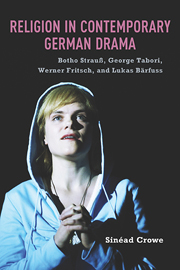 Religion in Contemporary German Drama
Religion in Contemporary German Drama Book contents
- Frontmatter
- Contents
- Acknowledgments
- Introduction: Definitions and Themes
- 1 The Relationship between Theater and Religion
- 2 Religion in Modern European Theater and Drama
- 3 “No One Wants to Get to God Anymore”? Botho Strauß's Groß und klein and Die eine und die andere
- 4 Theological Farce: George Tabori's Mein Kampf
- 5 “The Last Refuge for Metaphysics”: Werner Fritsch's Theater Theory
- 6 “The Feeling of Faith”: Fritsch's Wondreber Totentanz and Aller Seelen
- 7 Belief and Unbelief in the Twenty-First Century: Lukas Bärfuss's Der Bus (Das Zeug einer Heiligen)
- Conclusion
- Bibliography
- Index
6 - “The Feeling of Faith”: Fritsch's Wondreber Totentanz and Aller Seelen
Published online by Cambridge University Press: 05 May 2013
- Frontmatter
- Contents
- Acknowledgments
- Introduction: Definitions and Themes
- 1 The Relationship between Theater and Religion
- 2 Religion in Modern European Theater and Drama
- 3 “No One Wants to Get to God Anymore”? Botho Strauß's Groß und klein and Die eine und die andere
- 4 Theological Farce: George Tabori's Mein Kampf
- 5 “The Last Refuge for Metaphysics”: Werner Fritsch's Theater Theory
- 6 “The Feeling of Faith”: Fritsch's Wondreber Totentanz and Aller Seelen
- 7 Belief and Unbelief in the Twenty-First Century: Lukas Bärfuss's Der Bus (Das Zeug einer Heiligen)
- Conclusion
- Bibliography
- Index
Summary
WONDREBER TOTENTANZ: TRAUMSPIEL and Aller Seelen: Traumspiel, two explorations of the National Socialist past set in or around his native Upper Palatinate region of Bavaria, are prime examples of the memory work for which Fritsch is best known. They both demonstrate the religiose quality that is also characteristic of Fritsch's theater, for religious elements pervade virtually all semiotic levels, from the titles, characters, and language to aspects of the mise en scène such as stage decoration, costumes, music, and lighting. In fact, the religious signs are too numerous to examine exhaustively in one chapter. This chapter therefore focuses on some representative examples, devoting special attention to the question of how religious signs are used to realize the programmatic aims discussed in the previous chapter.
Plot and Structure: The Dream-Play and the “Film of Life”
Wondreber Totentanz is a densely textured, multileveled theatrical reworking of Fritsch's earlier radio play, Isidor Isidor (1993), and novel, Stechapfel: Legende (Thorn apple: Legend, 1995). It interweaves a number of narrative threads and therefore, like much postdramatic theater, lacks the kind of linear plot that can be easily synopsized. The framework of the play — what Fritsch refers to as “die sichtbare Ebene” (the visible level)1 — is the funeral Mass of Irmgard, a young woman who has been killed in a terrorist attack while on honeymoon in Egypt (one of many references to Egypt in this play). Her widowed husband, Isidor, is present at the funeral, but he is in a coma and near to death himself as a result of the attack.
- Type
- Chapter
- Information
- Religion in Contemporary German DramaBotho Strauß, George Tabori, Werner Fritsch, and Lukas Bärfuss, pp. 107 - 130Publisher: Boydell & BrewerPrint publication year: 2013
